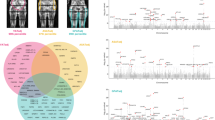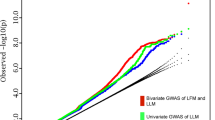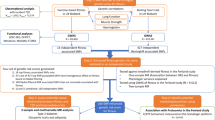Abstract
OBJECTIVE AND SUBJECTS: Interactions between markers in the β2- and β3-adrenergic receptor (ADR) genes and total body fat and computerized tomography-measured abdominal fat phenotypes were studied in the HERITAGE Family Study cohort of Black (n=205; 81 males and 124 females) and White (n=415; 198 males and 217 females) subjects before and after an endurance training program.
RESULTS: In Black subjects, β2- and β3-ADR gene variants showed evidence of interactions on changes in total body fat mass and abdominal fat area (P<0.005 and =0.010, respectively). Black subjects who were carriers of both β2-ADR Arg16 and β3-ADR Arg64 alleles had a greater decrease in total fat mass as well as abdominal total and subcutaneous, but not visceral fat areas in response to endurance training than subjects with other genotype combinations (P from 0.011 to 0.047). After correction for multiple tests, the findings remained essentially unchanged for total body fat mass and abdominal fat area, but became nonsignificant for subcutaneous fat area. The changes in abdominal fat correlated positively with the changes in fat mass (P<0.0001). The interactions between β2 and β3-ADR gene markers accounted for a maximum of 3% of the variances in the response of total fat mass and abdominal fat area to endurance training in Black subjects but it was not significant in White subjects.
CONCLUSION: Interactions between sequence variants in the β2–β3-ADR gene contributed to the changes in fat mass and abdominal adiposity in response to endurance training in Black subjects.
This is a preview of subscription content, access via your institution
Access options
Subscribe to this journal
Receive 12 print issues and online access
$259.00 per year
only $21.58 per issue
Buy this article
- Purchase on Springer Link
- Instant access to full article PDF
Prices may be subject to local taxes which are calculated during checkout


Similar content being viewed by others
References
Pérusse L, Després JP, Lemieux S, Rice T, Rao DC, Bouchard C . Familial aggregation of abdominal visceral fat level: results from the Québec Family Study. Metabolism 1996; 45: 378–382.
Rice T, Despres JP, Daw EW, Gagnon J, Borecki IB, Perusse L, Leon AS, Skinner JS, Wilmore JH, Rao DC, Bouchard C . Familial resemblance for abdominal visceral fat: The HERITAGE Family Study. Int J Obes Relat Metab Disord 1997; 21: 1024–1031.
Bouchard C . Current understanding of the etiology of obesity: genetic and nongenetic factors. Am J Clin Nutr 1991; 53 (Suppl): 1561S–1565S.
Buemann B, Vohl MC, Chagnon M, Chagnon YC, Gagnon J, Perusse L, Dionne F, Despres JP, Tremblay A, Nadeau A, Bouchard C . Abdominal visceral fat is associated with a BclI restriction fragment length polymorphism at the glucocorticoid receptor gene locus. Obes Res 1997; 5: 186–192.
Rosmond R, Chagnon YC, Holm G, Chagnon M, Perusse L, Lindell K, Carlsson B, Bouchard C, Björntorp P . A glucocorticoid receptor gene marker is associated with abdominal obesity, leptin and dysregulation of the hypothalamic–pituitary–adrenal axis. Obes Res 2000; 8: 211–218.
Ukkola O, Perusse L, Chagnon YC, Despres JP, Bouchard C . Interactions among the glucocorticoid receptor, lipoprotein lipase and adrenergic receptor genes and abdominal fat in the Quebec Family Study. Int J Obes Relat Metab Disord 2001; 25: 1332–1339.
Ukkola O, Rankinen T, Weisnagel SJ, Sun G, Perusse L, Chagnon YC, Despres JP, Bouchard C . Interactions among the α2-, β2-, and β3-adrenergic receptor genes and obesity-related phenotypes in the Quebec Family Study. Metabolism 2000; 49: 1063–1070.
Dionne IJ, Turner AN, Tchernof A, Pollin TI, Avrithi D, Gray D, Shuldi ET . Identification of an interactive effect of β3- and α2b-adrenoceptor gene polymorphisms on fat mass in Caucasian women. Diabetes 2001; 50: 91–95.
Bouchard C, Leon AS, Rao DC, Skinner JS, Wilmore JH, Gagnon J . The HERITAGE Family Study: aims, design, and measurement protocol. Med Sci Sports Exerc 1995; 27: 721–729.
Skinner JS, Wilmore KM, Jaskolska A, Jaskolski A, Daw EW, Rice T, Gagnon J, Leon AS, Wilmore JH, Rao DC, Bouchard C . Reproducibility of maximal exercise test data in the HERITAGE Family Study. Med Sci Sports Exerc 1999; 31: 1623–1628.
Wilmore JH, Stanforth PR, Domenick MA, Gagnon J, Daw EW, Leon AS, Rao DC, Skinner JS, Bouchard C . Reproducibility of anthropometric and body composition measurements: The HERITAGE Family Study. Int J Obes Relat Metab Disord 1997; 21: 297–303.
Sjostrom L, Kvist H, Cederblad A, Tylen U . Determination of total adipose tissue and body fat in women by computed tomography, 40 K, and tritium. Am J Physiol 1986; 250: E736-–E745.
Keselman HJ . Stepwise multiple comparisons of repeated measures means under violations of multisample sphericity. In: Hoppe FM (ed). Multiple comparisons, selection, and applications in biometry. Marcel Dekker Inc.: NY; 1993, pp 167–186.
Arner P, Kriegholm E, Engfeldt P, Bolinder J . Adrenergic regulation of lipolysis in situ at rest and during exercise. J Clin Invest 1990; 85: 893–898.
Bouchard C, Rice T, Lemieux S, Despres JP, Perusse L, Rao DC . Major gene for abdominal visceral fat area in the Quebec Family Study. Int J Obes Relat Metab Disord 1996; 20: 420–427.
Rice T, Despres JP, Perusse L, Gagnon J, Leon AS, Skinner JS, Wilmore JH, Rao DC, Bouchard C . Segregation analysis of abdominal visceral fat: the HERITAGE Family Study. Obes Res 1997; 5: 417–424.
Liggett SB . Molecular and genetic basis of β2-adrenergic receptor function. J Allergy Clin Immunol 1999 (Suppl)); 103: S42–S46.
Large V, Hellstrom L, Reynisdottir S, Lonnqvist F, Eriksson P, Lannfelt L, Arner P . Human β2-adrenoceptor gene polymorphisms are highly frequent in obesity and associate with altered adipocyte β2-adrenoceptor function. J Clin Invest 1997; 100: 3005–3013.
Umekawa T, Yoshida T, Sakane N, Kogure A, Kondo M, Honjyo H . Trp64Arg mutation of β3-adrenoceptor gene deteriorates lipolysis induced by β3-adrenoceptor agonist in human omental adipocytes. Diabetes 1999; 48: 117–120.
Tchernof A, Starling RD, Turner A, Shuldiner AR, Walston JD, Silver K, Poehlman ET . Impaired capacity to lose visceral adipose tissue during weight reduction in obese postmenopausal women with the Trp64Arg β3-adrenoceptor gene variant. Diabetes 2000; 49: 1709–1713.
Widen E, Lehto M, Kanninen T, Walston J, Shuldiner AR, Groop LC . Association of a polymorphism in the β3-adrenergic-receptor gene with features of the insulin resistance syndrome in Finns. N Engl J Med 1995; 333: 348–351.
Sipiläinen R, Uusitupa M, Heikkinen S, Rissanen A, Laakso M . Polymorphism of the β3-adrenergic receptor gene affects basal metabolic rate in obese Finns. Diabetes 1997; 46: 77–80.
Tchernof A, Starling RD, Walston JD, Shuldiner AR, Dvorak RV, Silver K, Matthews DE, Poehlman ET . Obesity-related phenotypes and the β3-adrenoceptor gene variant in postmenopausal women. Diabetes 1999; 48: 1425–1428.
Mitchell BD, Blangero J, Comuzzie AG, Almasy LA, Shuldiner AR, Silver K, Stern MP, MacCluer JW, Hixson JE . A paired sibling analysis of the β3-adrenergic receptor and obesity in Mexican Americans. J Clin Invest 1998; 101: 584–587.
Kawamura T, Egusa G, Okubo M, Imazu M, Yamakido M . Association of β3-adrenergic receptor gene polymorphism with insulin resistance in Japanese-American men. Metabolism 1999; 48: 1367–1370.
Thomas GN, Tomlinson B, Chan JC, Young RP, Critchley JA. The Trp64Arg polymorphism of the β3-adrenergic receptor gene and obesity in Chinese subjects with components of the metabolic syndrome. Int J Obes Relat Metab Disord 2000; 24: 545–551.
Sakane N, Yoshida T, Umekawa T, Kogure A, Takakura Y, Kondo M . Effects of Trp64Arg mutation in the β3-adrenergic receptor gene on weight loss, body fat distribution, glycemic control, and insulin resistance in obese type 2 diabetic patients. Diabetes Care 1997; 20: 1887–1890.
Allison DB, Heo M, Faith MS, Pietrobelli A . Meta-analysis of the association of the Trp64Arg polymorphism in the β3-adrenergic receptor with body mass index. Int J Obes Relat Metab Disord 1998; 22: 559–566.
Fujisawa T, Ikegami H, Kawaguchi Y, Ogihara T . Meta-analysis of the association of Trp64Arg polymorphism of β3-adrenergic receptor gene with body mass index. J Clin Endocrinol Metab 1998; 83: 2441–2444.
Garenc C, Perusse L, Rankinen T, Gagnon J, Leon AS, Skinner JS, Wilmore JH, Rao DC, Bouchard C . The Trp64Arg polymorphism of the β3-adrenergic receptor gene is not associated with training-induced changes in body composition: The HERITAGE Family Study. Obes Res 2001; 9: 337–341.
Acknowledgements
The HERITAGE Family Study is supported by the National Heart, Lung, and Blood Institute through Grants HL-45670 (to C Bouchard), HL-47323 (to AS Leon), HL-47317 (to DC Rao), HL-47327 (to JS Skinner) and HL-47321 (to JH Wilmore). AS Leon is partially supported by the Henry L Taylor endowed Professorship in Exercise Science and Health Enhancement. C Bouchard is supported in part by the George A Bray Chair in Nutrition.
Author information
Authors and Affiliations
Corresponding author
Rights and permissions
About this article
Cite this article
Ukkola, O., Rankinen, T., Rice, T. et al. Interactions among the β2- and β3- adrenergic receptor genes and total body fat and abdominal fat level in the HERITAGE Family Study. Int J Obes 27, 389–393 (2003). https://doi.org/10.1038/sj.ijo.0802248
Received:
Revised:
Accepted:
Published:
Issue Date:
DOI: https://doi.org/10.1038/sj.ijo.0802248
Keywords
This article is cited by
-
Association of adipose tissue deposition and beta-2 adrenergic receptor variants: the IRAS family study
International Journal of Obesity (2005)
-
Association Between Body Fat Response to Exercise Training and Multilocus ADR Genotypes
Obesity Research (2004)



